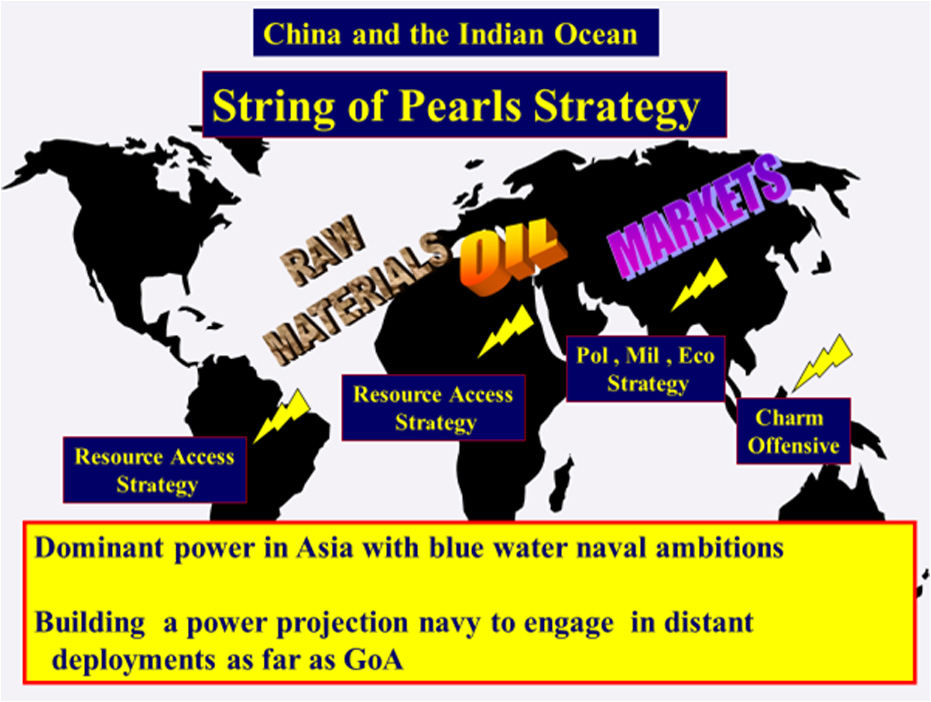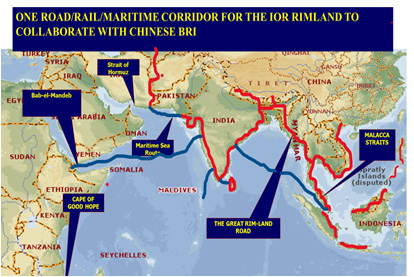The Indo-Pacific region is becoming a playground of great Geopolitical powerplay and thus attracting many a scholar to analyze the power equations at play. The Indian Ocean is becoming increasingly important to China’s economic and security interests. To protect its economic and security interests and to balance a “rising India,” China appears to be pursuing a simultaneous approach of cultivating relations with many states in the Indian Ocean littoral, as well as developing a “String of pearls” of bases and access rights to key facilities in the region through it’s MSR strategy. China’s encirclement of India comes full circle by its increased presence not only at sea but on land borders with its increased military bases at TAR and Aksai Chin coupled with infrastructure development by its military engineers in PoK.
US-Japan-India-Australia Strategic Partnership (The QUAD)
With the advent of Chinese ambitions in the Indo-Pacific it is but natural that the four major players in the Indo-Pacific, focus their energies together as an alliance, if not to directly threaten the Chinese overtures, but certainly to re-balance the power equation in the region in order to give more breathing space to smaller countries who are likely to get sucked into the Chinese whirlpool. Although this alliance has loosely been formed already, nothing concrete has been done till date to counter the Chinese Juggernaut. Whereas China is strategizing in both the Heartland and the Rim-land realms, the Alliance is still literally at sea, taking stock of the Rim-land and offshore of it. Its first official meet in the shadows of the ASEAN summit has raised many Chinese eyebrows.
During a recent interaction with Strobe Talbott and John Allen in the Brookings Foundation at New Delhi, when asked about the Chinese Predicament, the answer was a cautious geopolitically correct statement that US is following a policy of four C’s in the region against China, namely Cooperate wherever possible, Compete for limited resources, settle for Conflict Resolution whenever possible and be prepared for Confrontation. The big question is if this is enough.
In India, the Alliance sees a fiercely independent strong-willed partner who has shown its resolve by not participating in the Belt Road Initiative and gone to the extent of blocking Chinese unilateral expansionism in a third country namely Bhutan during the Doklam crisis.
Opportunities for the QUAD
- Assist in economic upliftment of the ASEAN region to give competition to the Chinese Industry.
- Connect India’s vision of the Act east policy through an economic corridor connection the South East Asian states to South Asia.
- The Alliance should focus on providing connectivity to South Asia and South East Asia via aRoad/Rail/Maritime corridor, thereby creating the concept of ONE ROAD for the many roads that China is constructing through its Belt Road Initiatives in the region. This One road/high speed rail network should be supported externally by the alliance and have the participation of all the countries of the region, in no way being against or exclusive of Chinese interests, giving full visiting and connecting rights to China, albeit on an equal footing.
- Rebalancing Power Equations with Iran – The Geostrategic importance of Iran cannot be neglected by the QUAD alliance even though the dominant partner in the Alliance, US may have its reservations due to Iran’s support to Hezbollah in Syria and Lebanon and the Houthis in Yemen. Iran provides the gateway to the heartland of Asia thereby providing a corridor to the oil, gas and Mineral-rich CARs as well as an alternative route to strife-torn Afghanistan. As the Chinese ambitions in the CPEC fructify into concrete, the access to Afghanistan and beyond to CARs will automatically get restricted through Pakistan.
- Strategic Partnership with the Russian Federation -Though does not look feasible as of today, the alliance must join hands with the Russian Federation only for limited interests in the region. India could be utilised effectively for this due to the trust it enjoys because of a long-lasting treaty of friendship with the Russians. The baggage of NATO, Eastern Europe and Syria can no longer be brought to the Indo Pacific in case the QUAD is serious to counter the Chinese Juggernaut.
Threats for the QUAD
- Empty handshakes and sweet talk without any serious action and economic support by the Alliance could be a serious threat for Security in the region.
- State sponsored terrorism and support to proxy war through Terrorism could be a serious threat to progress.
- Nuclear Brinkmanship or Blackmail whether it is by Pakistan or North Korea at the behest of China will be a problem that will need to be thought through.
- The regional imbalance created by the Shia-Sunni divide may lead to reorientations in the region which could have disastrous results.
The Russian Federation
Russia has gone through tumultuous times and is coming in its own under the leadership of President Putin. When on 26 December 1991 Gorbachev announced the world that the USSR ceased to exist and that it would be hither to fore divided into 15 independent republics, the world was shocked and hurriedly President Bush came on air in USA and declared that the US had won the cold war. Having relegated the Russian Federation to a back seat, no one their wildest dreams could have imagined that it would become as relevant as it is today, albeit still a shadow of its strong past.
Working relentlessly towards its core natural interests it was only a matter of time that the Crimean Peninsula came in the lap of the Russians which had been traditionally housing their only warm water fleet ie, in the Black sea. Having been restricted by the Bosphorus Straits and the Dardenneles for centuries, the Russians had to maintain their interest in Syria where they have enjoyed a Military port facility at Latakia. Aligning with Iran to fight the ISIS was a geostrategic necessity.
It is also but natural that some of the weak electron states which had broken away from Russia and have a sizeable Ethnic Russian population, get pulled by the strong gravitational pull of the Russian core.
Geopolitically a lot will continue to happen in Heartland Europe which will have long term strategic implications due to the involvement of NATO and the Cold war baggage being carried even today. The question is whether the world should keep them from fighting the scourge of Terrorism as a combined lot and say, get semblance in the Economic and Strategic power equation with China which is tilting steadily in its favour.
Russia in the meantime has also entered with China in an unequal partnership where China is playing the dominant role. China has through a geostrategic masterstroke (which can be compared to Hitler’s treaty with Stalin before the start of the second world war) resolved all border disputes with Russia.
Opportunities for Russia
- Russia’s recent success against the ISIS in Syria can be utilised by it as a champion of the free world against Terrorism.
- Rejuvenation of its defence industry can be a stepping stone to higher sales and dependence on it by the developing world.
- Russia could partner with India for developing exclusive ship building ports on the Rim-land road, both on the West and East coast of India, thereby leveraging its ship building Industry and prowess as well as get access to warm water ports, in case their interests are threatened by China in the future.
- Its forays into the unchartered area of Artificial Intelligence could lead to unforeseen options.
- Russia could play a major role in conflict resolution as a dominant “other power” in a unipolar world where declared nuclear states like North Korea place more trust in it.
- May act as a balancing factor in the Shia-Sunni divide which is tearing the world in two.
- By maintaining its ideological and linguistic relations with the CARs it could be anequating force in the SCO region thereby denying a free run to China in the region.
- By continuing to extend its supply of mineral resources including critical gas for heartland Europe it could ensure extension of its soft power.
- Could be a critical catalyst to direct the energies of Iran for combined progress of the region including the CARs and Afghanistan.
Threats for Russia
- Increased confrontation with countries of Heartland Europe could lead to a deteriorating security situation in the region.
- Its unconditional support to the Shia cause could lead to a deepening fracture in the Shia-Sunni world which may in turn lead to further Radicalisation and resultant chaos.
- Allowing China to freely negotiate BRI deals in the Eurasian heartland could lead to loss of traditional control over the CARs.
- The Russian Federation has an unequal population and resource distribution. 80 percent of its population is concentrated towards the west in Europe whereas 90 percent of its mineral resources are concentrated towards the East. The Russians have to keep the Chinese threat to their Eastern half alive in their minds, lest they are surprised again as they were in 1941 when in spite of a treaty, Hitler invaded Russia for Grains and mineral resources.
Conclusion
It is very evident from the above analysis that Chinese forays into the Eurasian heartland are primarily for Economic reasons and towards the rim-land of the Indo-Pacific(including towards Eastern Russia) for Strategic reasons. Presently it is cruising at great speed as it has forayed into areas wherever it felt there was a decisive void. The world is being dealt with by the Chinese in a piece meal manner, bilaterally, as it suites China. Make no mistake that it is following a planned path, for what is long term for many in the world (say 30 years-time horizon) may be short term for China.
As it progresses patiently, the Juggernaut grows and will shortly have clear cut global ambitions like Hitler’s Germany before the second great war.
It becomes the duty of all powers mentioned in the analys is above to join hands and do concrete actions in the ‘Opportunities dimension’ ASAP otherwise we may see many a war and strife in the future. A road for a road today may degrade Chinese unilateralism and thereby prevent the loss of millions of lives in the future.
By no means do I propose to the world to choke the ambitions of a developing China, but only make conditions for it to become collaborative. If concrete steps are not taken immediately there is only one country winning twice in a win-win relationship being proposed by the Chinese in their BRI and there are no prizes for guessing who.
Courtesy: http://www.claws.in/1844/a-road-for-a-road-blocking-chinese-unilateralism-as-chonker.html







If only QUAD becomes Strategic military alliance there’s some hope of containing Chinese economic imperialism and geopolitical hegemony. Such a scenario seems less feasible given that Japan and Australia are committed US allies and with Chabahar being developed India can’t antagonise Iran , the Shiaite power which is opposed tooth and nail by US , a Sunni supporter. A paper alliance doesn’t serve the purpose of India and Japan which top the Chinese hit list. How reliable can US be also needs to be evaluated . US talks bug but never walks the talk.When Its unable to tacklel North Korea – proxy of China, can it put up a shield against China ?. India has to strengthen its Defence / offence capabilities on its own making use of the alliance to get transfer of know how in high tech areas. Economically , in alliance with Japan shore up the infrastructure to make the country a manufacturing hub , so that Asia Africa Growth initiative can make us financially strong. Of course this may need 5 – 7 years time. And in the mean time try geopolitical disruption of CPEC and BRI as putting breaks on Chinese economy will ensure crippling disruption of Chinese game plan.